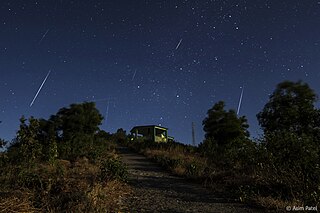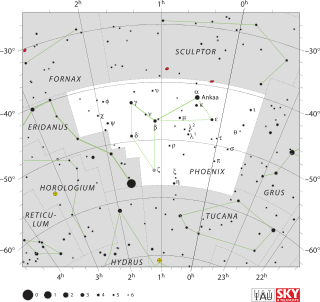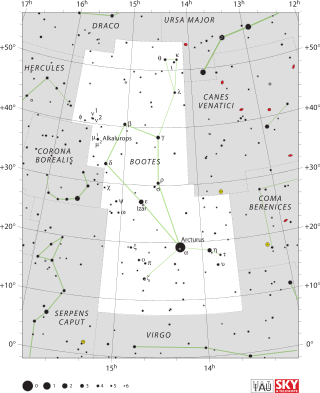Related Research Articles

Aquarius is an equatorial constellation of the zodiac, between Capricornus and Pisces. Its name is Latin for "water-carrier" or "cup-carrier", and its old astronomical symbol is (♒︎), a representation of water. Aquarius is one of the oldest of the recognized constellations along the zodiac. It was one of the 48 constellations listed by the 2nd century astronomer Ptolemy, and it remains one of the 88 modern constellations. It is found in a region often called the Sea due to its profusion of constellations with watery associations such as Cetus the whale, Pisces the fish, and Eridanus the river.

The Geminids are a prolific meteor shower caused by the object 3200 Phaethon, which is thought to be an Apollo asteroid with a "rock comet" orbit. This would make the Geminids, together with the Quadrantids, the only major meteor showers not originating from a comet. The meteors from this shower are slow moving, can be seen in December and usually peak around December 4–16, with the date of highest intensity being the morning of December 14. Recent showers have seen 120–160 meteors per hour under optimal conditions, generally around 02:00 to 03:00 local time. Geminids were first observed in 1862, much more recently than other showers such as the Perseids and Leonids.

A meteor shower is a celestial event in which a number of meteors are observed to radiate, or originate, from one point in the night sky. These meteors are caused by streams of cosmic debris called meteoroids entering Earth's atmosphere at extremely high speeds on parallel trajectories. Most meteors are smaller than a grain of sand, so almost all of them disintegrate and never hit the Earth's surface. Very intense or unusual meteor showers are known as meteor outbursts and meteor storms, which produce at least 1,000 meteors an hour, most notably from the Leonids. The Meteor Data Centre lists over 900 suspected meteor showers of which about 100 are well established. Several organizations point to viewing opportunities on the Internet. NASA maintains a daily map of active meteor showers.

The Perseids are a prolific meteor shower associated with the comet Swift–Tuttle that are usually visible from mid-July to late-August. The meteors are called the Perseids because they appear from the general direction of the constellation Perseus and in more modern times have a radiant bordering on Cassiopeia and Camelopardalis.
The Quadrantids (QUA) are a meteor shower that peaks in early January and whose radiant lies in the constellation Boötes. The zenithal hourly rate (ZHR) of this shower can be as high as that of two other reliably rich meteor showers, the Perseids in August and the Geminids in December, yet Quadrantid meteors are not seen as often as those of the two other showers because the time frame of the peak is exceedingly narrow, sometimes lasting only hours. Moreover, the meteors are quite faint, with mean apparent magnitudes between 3.0 and 6.0.

46P/Wirtanen is a small short-period comet with a current orbital period of 5.4 years. It was the original target for close investigation by the Rosetta spacecraft, planned by the European Space Agency, but an inability to meet the launch window caused Rosetta to be sent to 67P/Churyumov–Gerasimenko instead. It belongs to the Jupiter family of comets, all of which have aphelia between 5 and 6 AU. Its diameter is estimated at 1.4 kilometres (0.9 mi). In December 2019, astronomers reported capturing an outburst of the comet in substantial detail by the TESS space telescope.

The pi Puppids are a meteor shower associated with the comet 26P/Grigg-Skjellerup. The meteoroid streams approach the Sun at around 37 km/s and have to overtake Earth that is orbiting the Sun at 30 km/s, resulting in atmospheric entry at a relatively slow 15 km/s.

The Ursid (URS) meteor activity begins annually around December 17 and runs for over a week, until the 25th or 26th. This meteor shower is named for its radiant point, which is located near the star Beta Ursae Minoris (Kochab) in the constellation Ursa Minor.

The Eta Aquariids are a meteor shower associated with Halley's Comet. The shower is visible from about April 19 to about May 28 each year with peak activity on or around May 5. Unlike most major annual meteor showers, there is no sharp peak for this shower, but rather a broad maximum with good rates that last approximately one week centered on May 5. The meteors we currently see as members of the Eta Aquariid shower separated from Halley's Comet hundreds of years ago. The current orbit of Halley's Comet does not pass close enough to the Earth to be a source of meteoric activity.
The Taurids are an annual meteor shower, associated with the comet Encke. The Taurids are actually two separate showers, with a Southern and a Northern component. The Southern Taurids originated from Comet Encke, while the Northern Taurids originated from the asteroid 2004 TG10, possibly a large fragment of Encke due to its similar orbital parameters. They are named after their radiant point in the constellation Taurus, where they are seen to come from in the sky. Because of their occurrence in late October and early November, they are also called Halloween fireballs. Since 2P/Encke is such a short period comet, the meteors have the slowest impact speed of the annual well-known meteor showers.

The Phoenicids are a minor meteor shower, first noticed by observers in New Zealand, Australia, the Indian Ocean, and South Africa during an outburst of approximately 100 meteors an hour that occurred during December 1956. Like other meteor showers, the Phoenicids get their name from the location of their radiant, which is in the constellation Phoenix. They are active from 29 November to 9 December, with a peak occurring around 5/6 December each year, and are best seen from the Southern Hemisphere.

The Orionids meteor shower, often shortened to the Orionids, is one of two meteor showers associated with Halley's Comet. The Orionids are so-called because the point they appear to come from, called the radiant, lies in the constellation Orion, but they can be seen over a large area of the sky. The Orionids are an annual meteor shower which last approximately one week in late October. In some years, meteors may occur at rates of 50–70 per hour.

The Arietids are a strong meteor shower that lasts from May 22 to July 2 each year, and peaks on June 7. The Arietids, along with the Zeta Perseids, are the most intense daylight meteor showers of the year. The source of the shower is unknown, but scientists suspect that they come from the asteroid 1566 Icarus, although the orbit also corresponds similarly to 96P/Machholz.
The Andromedids meteor shower is associated with Biela's Comet, the showers occurring as Earth passes through old streams left by the comet's tail. The comet was observed to have broken up by 1846; further drift of the pieces by 1852 suggested the moment of breakup was in either 1842 or early 1843, when the comet was near Jupiter. The breakup led to particularly spectacular showers in subsequent cycles.

The Tau Herculids are a meteor shower that when discovered in 1930 appeared to originate from the star Tau Herculis. The parent comet of the Tau Herculids is periodic comet Schwassmann-Wachmann 3 with a 5.4 year orbital period. This meteor shower occurs from May 19 - June 19. The meteor shower was first observed by the Kwasan Observatory in Kyoto, Japan in May 1930. The Tau Herculids' average radiant was α=236°, δ=+41°. Due to orbital perturbations of the meteor streams by Jupiter, 2022 activity will have a radiant of R.A. = 13:56 (209), Decl. = +28. The meteors are relatively slow moving making atmospheric entry at around 16 km/s (36,000 mph).

Leonis Minorids is a weak meteor shower that takes place from October 13 till November 3 each year, peaking around October 20–23. With a weak moon the meteor shower may be visible with the naked eye, however this meteor shower is best observed only from the Northern Hemisphere with telescopic plotting. This meteor shower is linked to comet C/1739 K1 and radiates from the constellation Leo Minor, which is a faint constellation north of Leo. The meteor shower often only produces 2 meteors an hour. The meteors pass at an average speed of 62 kilometers per second.

The Alpha Monocerotids is a meteor shower active from 15 to 25 November, with its peak occurring on 21 or 22 November. The speed of its meteors is 65 km/s, which is close to the maximum possible speed for meteors of about 73 km/s. Normally it has a low Zenithal Hourly Rate (ZHR), but occasionally it produces much more intense meteor storms that last less than an hour: such outbursts were observed in 1925, 1935, 1985, and 1995. The 1925 and 1935 storms both reached levels passing 1,000 ZHR.

209P/LINEAR is a periodic comet with an orbital period of 5.1 years. The comet has extremely low activity for its size and is probably in the process of evolving into an extinct comet.

Comet 252P/LINEAR is a periodic comet and near-Earth object discovered by the LINEAR survey on April 7, 2000. The comet is a Jupiter family comet, meaning that it passes quite close to the orbit of Jupiter.
References
- 1 2 3 Jenniskens, Peter (2006). "The sunskirting streams: Arietids and δ-Aquariids". Meteor Showers and Their Parent Comets. Cambridge University Press. pp. 423–37. ISBN 978-0-521-85349-1.
- ↑ "Meteor Shower Calendar | IMO | Page 2009" . Retrieved 2022-09-27.
- 1 2 "Meteor Showers Online".
- ↑ Öpik, Ernst (September 1950). "Interstellar Meteors and Related Problems". Irish Astronomical Journal. 1 (3): 80–96. Bibcode:1950IrAJ....1...80O.
